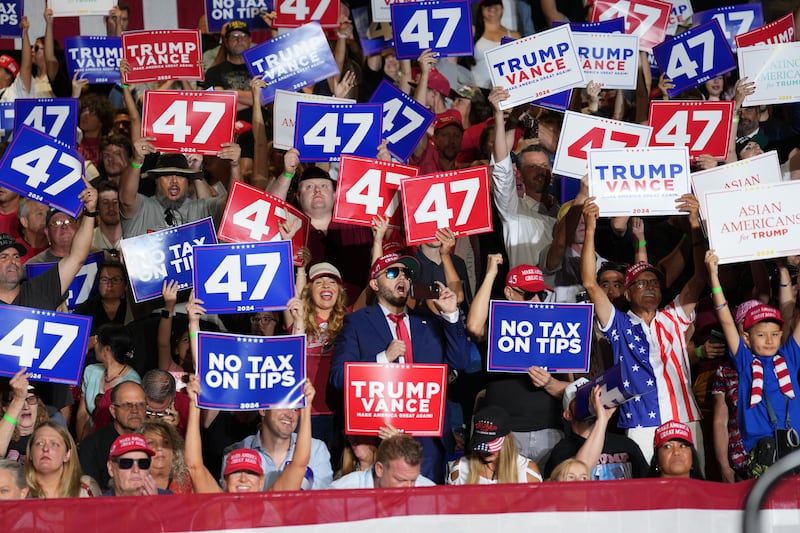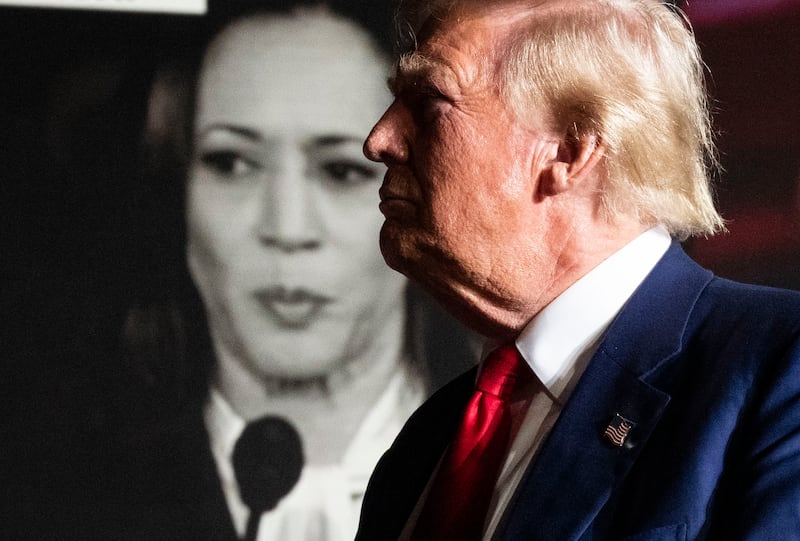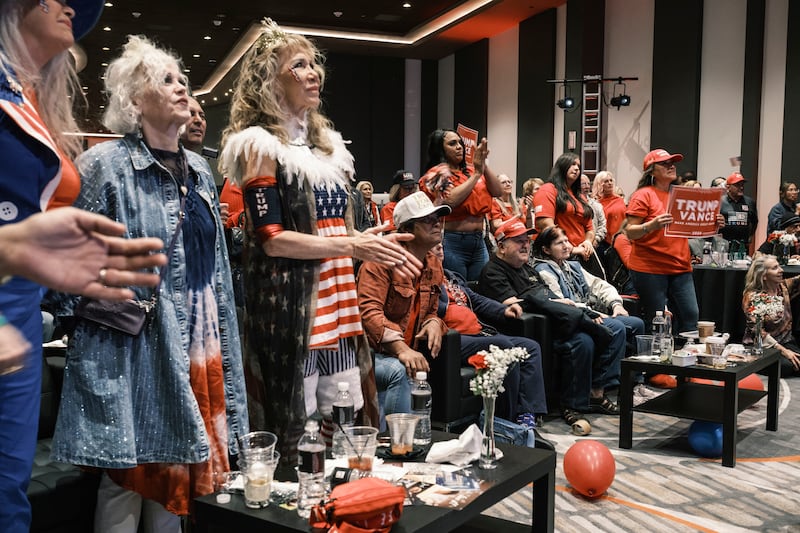On the morning after president Joe Biden’s implosion in his election debate against Donald Trump in Atlanta, Benjamin, who drives an Uber, shook his head in slow disbelief when I asked if he had been watching the night before. He, along with 67 million viewers, had caught some of the debacle – enough to confirm what he already suspected. He sighed as he gave his verdict. “He’s too old. He’s gotta go.”
We chatted for a while that morning about who might replace Biden. This was late June. Benjamin didn’t see Kamala Harris as a plausible alternative and other names – Whitmer, Buttigieg – would not register, he felt, with enough voters. Considering the high-profile governor Gavin Newsom, Benjamin said: “Nuh-oh. Newsom’s California. California’s a sh**show. Nobody wants nobody from California runnin’ nothin.”
As we chatted, Benjamin told me that his main concern, as an American father with a young family, was “the economy”. He meant, he went on, the family economy: the brutal, inescapable cost of living. He gave specific examples: a dozen specific-brand eggs that cost under three dollars four years ago now closer to seven – and climbing; chicken breasts, milk – family staples that had once been an afterthought – were now causing him and his partner to marvel at what was happening. And it was everything – rent, insurance, bills. It made it hard to get on with the quintessential American pursuit: that of happiness. It was the main reason he figured he’d vote for Donald Trump in November. “He’s a businessman,” he shrugged. “He’ll get things done.”
For almost a year, Americans of all age, ethnicity, background and geographical location had offered variations on the same theme. Last month there was Dale, a 92-year-old patriarch of an august family orchard business in a pastoral dreamland in Wisconsin, his eyes widening with alarm when he said the past four years were the toughest he’d encountered in five decades. Or Sarah, a Puerto Rican woman who volunteered for the Trump campaign and who told me, before Trump’s election eve rally in Reading: “I feel like they have a foot on my neck and allow me just enough air to survive. But I can’t breathe.”
RM Block
Or Vince Nuendorff, a lean, fresh-faced Iowan who on an eye-wateringly freezing January morning spoke of his search for an alternative after listening to Nikki Haley explain what she would bring as a Republican candidate. He had liked what he had heard. “We are a country divided and a country in chaos,” he said. “And we want someone who is going to bring us together.”
[ Donald Trump returns to power and thrusts America into the unknownOpens in new window ]

Vince was silent for a moment when asked when he felt the best time to be an American had been. “In my lifetime? Under Ronald Reagan. He was charismatic and he didn’t do everything right. But he was in front of the people and he was believable.”
Or the old friends at a February rally in Conway, South Carolina, when Trump was closing in on the Republican nomination: by then, Haley was the only other contender standing. “I think he does love America,” Dickie Woodward said of Trump. “And what it used to be. And we are moving away from what this country was 30 years ago. It seems like the 1 per cent has become the majority in voice. It might be the media are behind it, pushing their agenda. You hear a lot of this leftist socialist sort of intertwined and seem to be the same beast. Seems to be where they want to take this country.”
His friend added: “We grew up with the United States label. ‘Made in the United States’. And we want it back.”
One of the contrasts running through the apocalyptic vision Donald Trump offered of the United States during his barnstorming rallies through the heartland – migrants running amok, America a laughing stock, the radical liberal threat of Joe Biden and, subsequently, of Harris – is that his supporters could also hear, in his voice and his message, a wistful note running beneath the terrifying surface description. They heard in Trump again and again what the Democratic message has failed to offer: a clear, direct promise to return Americans to a better version of their country.
[ Donald Trump’s economic plan: the key areas for IrelandOpens in new window ]
It was never a point that Trump oversold and he didn’t have to. For tens of millions of ordinary Americans, the present is sufficiently grim that they were all too ready to remember better times. So, Trump repeatedly asked the electorate to recall the favourable costs of living when he was president just four quick years ago. It was not a difficult invitation to take up.
Americans believe they understand who Donald Trump is, flaws and all. And through allying the staggering cost-of-living crisis to his darkly rhapsodic visions of an American hell caused by the migrant invasion, he told a repeated and simple story of how the Biden administration had made a mess of things.

His devout Maga fan base may have delighted in the shock-jock rhetoric and performative antics simply because it appalled the commentariat in the priggish, woke, mainstream media. But millions of others simply tolerated or ignored it. And many moderate Trump fans suspected that his myriad court cases were part of a conspiracy to hinder if not prevent his re-election bid. And even if a considerable number of 2016 and 2020 Trump voters had serious reservations about his actions on January 6th, 2021, well, the moment passed and it would not happen again.
On Tuesday night, the most divisive presidential election in living memory was just hours in when the roof began to cave on the Democratic Party perception of where it stands in the hearts and minds of ordinary voters. All night, the analysts marvelled at the diversity of the demographic voting patterns now drawn to Trump Republicanism. Even the steadfast blue states like New York and New Jersey and specific spots in Massachusetts returned voting patterns that suggested their reliable constituents were losing faith.
They only had to look at the illustrations of the simple national map of the blue/red Republican and Democratic divide. Most of the south, the Great Plains, the midwestern states and the border states have been irredeemably red for decades. The electoral map of 1964, when Lyndon Johnson destroyed Barry Goldwater, who won just Arizona and the ribbon of five states of the Deep South, looks miraculous from a Democratic perspective now.
Blue collar Americans who, yes, care about democracy. But they also want to take their kids to Disneyworld. And they can’t afford it. And they are also driving a car that is a little shaky. And they are afraid to buy a new one. And that just trumps everything else. Forgive the word. But it does
— CNN’s John King
The country once ran blue from Texas right up to North Dakota. Over the next four years, with the Democrats aligned to the civil rights movement, and therefore to the cities, the national political colour scheme changed radically. Eight years ago, Donald Trump’s successful infiltration of the cherished blue wall states of Pennsylvania, Wisconsin and Michigan destroyed Democratic expectations of a Hillary Clinton presidency. This year, he chased the same terrain with the same success.
On Thursday, CNN’s John King, who spent the past year and a half returning brilliant, warning reports from the livingrooms and cafes of people in the swing states, explained it this way. He took the examples of Erie and Northampton, Pennsylvanian counties whose majority voted for Obama (twice), then Trump, then Biden and now Trump again.
“The swing counties? The 55 counties? Donald Trump won most of them,” King said. “And what do they have in common? Blue collar Americans who, yes, care about democracy. But they also want to take their kids to Disneyworld. And they can’t afford it. And they are also driving a car that is a little shaky. And they are afraid to buy a new one. And that just trumps everything else. Forgive the word. But it does.”
That was the 2024 election condensed. And none of it equates with the Democratic message of a macroeconomy that is thriving, however true that may be. Too many have come to feel as though the American Dream has become an American Existence. The deeper you travel through the interior states of the US, the hazier the reality of Washington DC. It’s not so much a place to many Americans as an idea, where faraway career bureaucrats and politicians who know nothing of their communities and traditions make what Dale described as “stupid” decisions that impact on their ways of life.
So, you drive through the stupendously ruined former industrial towns with their rows and rows of abandoned houses and shops and you see a constituency ignored by federal governments – of both hues – for many years. Or you drive through the tiny hamlets of Michigan’s majestic Upper Peninsula – 40,000sq km of natural splendour between the great lakes of Michigan and Superior with just 300,000 inhabitants, beautiful in summer and arctic in winter, with its lakeside cabins and drive-through marijuana stores. And try then to reconcile their living experience with that of the parched flatlands of central Texas, with its plethora of country music radio stations and murals to school football teams. And you then begin to understand why so many refer to the United States as an “experiment”.
Although a sparing public commentator, the novelist Barbara Kingsolver is one of the more piercing observers of that schism between city and country, urban and rural, elite and ordinary, which defines contemporary America. She grew up in Appalachia and lives there still and is a bard at explaining the vague sense of neglect that those of us merely passing through the seen-better-days-towns might intuit.
“The mines kept out other factories and mills that might have come in,” she said last month in a Guardian interview. “They owned everything: the land, the courthouse, politics. When coal left this region, it left an enormous void, which created a kind of hopelessness. I love Appalachian culture. It’s community based. It’s very self-sufficient. But you have this hopelessness that makes people vulnerable to politicians who say: ‘I’m on your side’.”

Enter, nine years ago, a complete political novice but also a well-known billionaire with New York moxie, a belligerent temperament, and a unique line in cruel humour. It may gall many ordinary Democratic representatives that Trump, a billionaire New Yorker, with the help of supporters like Elon Musk, a South African born into a millionaire family and now the richest person on the planet, have managed to connect with their old blue-collar constituency in ways that their party has failed to.
But there is the more subtle problem, too, that the Democrats are now deemed the party for that umbrella term “coastal metropolitan elites” who are condescending towards and baffled by the vast, ruggedly independent mindset of the interior. You can hear it in the urbane and sometimes funny, sometimes snooty, soliloquies of the nightly show hosts who mingle easily with celebrities and who mock Trump, nightly, tirelessly. It could be detected in the insult cast by Tim Walz, whose big moment was to call Trump and Vance “weird”.
The present – the America of right now – is diabolical, he told them. But I can change that. Let’s go back to what America used to be like
— Donald Trump told America
The Democrats loved it. But to many Americans, he may as well have been calling they themselves weird. And it is arguable that even the autumnal campaign speeches of Barack Obama, electrifying as his presence remains, contained the sense of a former symbol of hope in 2008 – “what began as a whisper in Springfield soon carried across the cornfields of Iowa” – now dropping in from some gilded height for an afternoon with the common folk. He still cast a spell to the listening audience as he advocated on behalf of Kamala Harris. But not enough were listening any more.
Sixty-eight million people voted for Harris. It’s a huge number of disappointed Americans. But almost 73 million opted for Trump. And in the end, it wasn’t the abstract threat of American democracy in jeopardy that motivated voters, nor what a Trump-government foreign policy programme may mean for the Middle East or Ukraine, nor the court cases, nor his onstage eccentricities and descents into crudeness, that concerned them most. It is that they feel their day-to-day lives have become a struggle to which they see no end.
Four years ago, the majority gave Joe Biden, a DC political veteran, a razor thin mandate. History may well return a generous verdict of his administration – and Donald Trump may land luckily and benefit from the true impact of the $1.2 trillion Infrastructure Investment and Jobs Act – Biden’s signature domestic achievement.
But that summer debate in Atlanta savagely exposed the frailties of age at the worst possible moment. He was gone as the Democratic candidate within a month. Over the next 100 days, Harris could not say or do enough to persuade the necessary number of Americans that she could rescue them from this feeling that they are being sucked into a bewildering future of out-of-whack costs, where the aspiration of owning a home – the cornerstone of the American dream – is increasingly out of reach.

In short, the new Republican Party as repurposed by Donald Trump won because the Democrats lost. Right now, the defeated party is poring over the charts of its traditional voting base – young black men, Latinos and Hispanics – walking away not in droves but in sufficient numbers to propel them into a full-blown crisis of identity. And the disenchanted have nowhere to walk but into the arms of Trump Republicanism. It is either/or.
The Harris campaign’s catch-cry of “We’re not going back” was clever, but also summed up the fear of many of those persuadable people who ultimately did not vote for her. For all of Donald Trump’s controversies, tens of millions Americans heard in his controversial and unique campaign what was a sales pitch comparable to Mad Men maestro Don Draper’s nostalgic depiction of the carousel Polaroid device. “It’s not a wheel. It’s a time machine,” Draper said, “that takes us to a place where we ache to go again.”
That ache is what Donald Trump, with that uncanny radar of his, sensed in the heartland as he gathered himself for a return to Washington, a city he described in the midwestern snows of January as “a rat infested sh**hole”. And as the Democratic Party became engulfed in its summer crisis, he made the same pitch again and again, through court cases and the shocking gunshots in Butler and the gruelling autumn tour of the country. The present – the America of right now – is diabolical, he told them. But I can change that. Let’s go back to what America used to be like.
In stressed times, that promise sounded like a better deal. Donald Trump is back. Now, all he has to do is to crank up the DeLorean and take them to that place.
- Sign up for push alerts and have the best news, analysis and comment delivered directly to your phone
- Find The Irish Times on WhatsApp and stay up to date
- Our In The News podcast is now published daily – Find the latest episode here





















